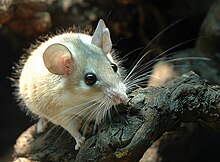
The Muroidea are a large superfamily of rodents, including mice, rats, voles, hamsters, lemmings, gerbils, and many other relatives. Although the Muroidea originated in Eurasia, they occupy a vast variety of habitats on every continent except Antarctica. Some authorities have placed all members of this group into a single family, Muridae, due to difficulties in determining how the subfamilies are related to one another. Many of the families within the Muroidea superfamily have more variations between the families than between the different clades. A possible explanation for the variations in rodents is because of the location of these rodents; these changes could have been due to radiation or the overall environment they migrated to or originated in. The following taxonomy is based on recent well-supported molecular phylogenies.

The Muridae, or murids, are either the largest or second-largest family of rodents and of mammals, containing approximately 870 species, including many species of mice, rats, and gerbils found naturally throughout Eurasia, Africa, and Australia.

The Cricetidae are a family of rodents in the large and complex superfamily Muroidea. It includes true hamsters, voles, lemmings, muskrats, and New World rats and mice. At over 870 species, it is the either the largest or second-largest family of mammals, and has members throughout the Americas, Europe and Asia.

The Nesomyidae are a family of African rodents in the large and complex superfamily Muroidea. It includes several subfamilies, all of which are native to either continental Africa or to Madagascar. Included in this family are Malagasy rodents, climbing mice, African rock mice, swamp mice, pouched rats, and the white-tailed rat.

The Eumuroida are a clade defined in 2004 by Steppan et al. to describe a group of muroid rodents. The clade is not defined in the standard taxonomic hierarchy, but it is between superfamily and family.

Pouched rats are a group of African rodents in the subfamily Cricetomyinae. They are members of the family Nesomyidae, which contains other African muroids such as climbing mice, Malagasy mice, and the white-tailed rat. All nesomyids are in the superfamily Muroidea, a large and complex clade containing 1⁄4 of all mammal species. Sometimes the pouched rats are placed in the family Muridae along with all other members of the superfamily Muroidea.

Dendromurinae is a subfamily of rodents in the family Nesomyidae and superfamily Muroidea. The dendromurines are currently restricted to Africa, as is the case for all extant members of the family Nesomyidae. The authorship of the subfamily has been attributed to both Alston, 1876, and (incorrectly) to G. M. Allen, 1939.

The Malagasy rodents are the sole members of the subfamily Nesomyinae. These animals are the only native rodents of Madagascar, come in many shapes and sizes, and occupy a wide variety of ecological niches. There are nesomyines that resemble gerbils, rats, mice, voles, and even rabbits. There are arboreal, terrestrial, and semi-fossorial varieties.

The Old World rats and mice, part of the subfamily Murinae in the family Muridae, comprise at least 519 species. Members of this subfamily are called murines. In terms of species richness, this subfamily is larger than all mammal families except the Cricetidae and Muridae, and is larger than all mammal orders except the bats and the remainder of the rodents.
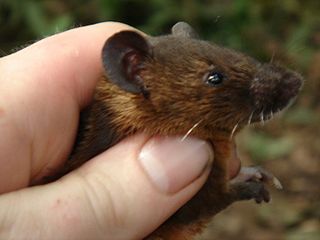
The brush-furred mice, genus Lophuromys are a group of rodents found in sub-Saharan Africa. They are members of the subfamily Deomyinae, a group only identifiable through molecular analysis. Lophuromys is also known as the brush-furred rats, harsh-furred rats or coarse-haired mice.
The link rat is a species of rodent in the family Muridae. It is also known by the common name Congo forest mouse. It is native to central Africa.
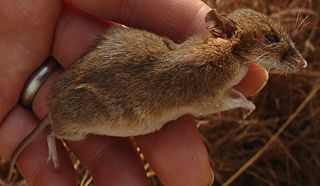
Rudd's mouse or the white-bellied brush-furred rat is the only species in the genus Uranomys. This animal is closely related to the spiny mice, brush-furred mice, and the link rat.
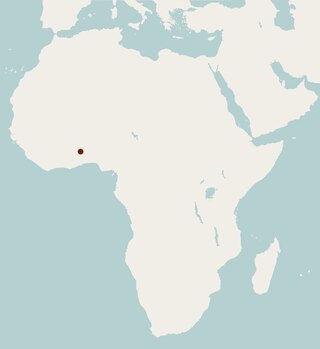
The Togo mouse, also known as Büttner's African forest mouse or the groove-toothed forest mouse, is a unique muroid rodent known from only two specimens taken from near the type locality of Bismarckburg, near Yege, Togo, in 1890. Its genus is monotypic.
Wilson's spiny mouse is a species of rodent in the family Muridae. It is found in Ethiopia, Kenya, Somalia, South Sudan, Tanzania, and Uganda. Its natural habitats are dry savanna, subtropical or tropical dry shrubland, and rocky areas.Molecular evidence suggests that spiny mice (Acomys) are genetically more closely related to gerbils (Gerbillinae) than they are to actual mice (Muridae) based on their murine morphology.
Hotson's mouse-like hamster also known as Hotson's calomyscus or Hotson's brush-tailed mouse is a species of rodent in the family Calomyscidae. It is endemic to southwestern Pakistan and southeastern Iran.
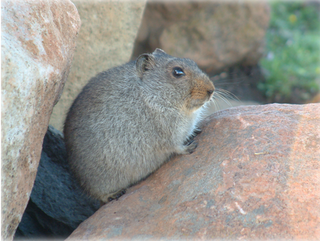
Otomyini is an Old World tribe of muroid rodents in the subfamily Murinae. Musser and Carleton (2005) granted it subfamily status (Otomyinae), but molecular studies consistently show that the otomyines evolved from within the Murinae, leading these researchers to subsume it in this subfamily, sometimes with tribal status. It includes 3 genera.

Millardini is a tribe of muroid rodents in the subfamily Murinae. Species in this tribe are found in South and Southeast Asia.
Praomyini is a tribe of muroid rodents in the subfamily Murinae. Species in this tribe are found mostly throughout Sub-Saharan Africa, but one species is found in North Africa, and another is found in the Arabian Peninsula.
